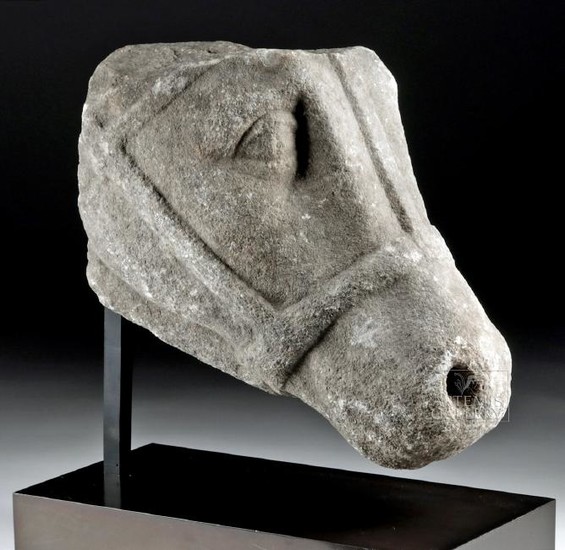Lifelike / Large Roman Marble Horse Head
Roman, Imperial Period, ca. 1st to 3rd century CE. A handsome, lifelike marble head of a horse, depicted with a bridle with headband and noseband. Your gaze is immediately drawn to the horse's large, sensitive eyes. The musculature of the horse's cheeks and snout are well-depicted, so that you believe you are seeing a powerful animal in the prime of its life. The marble has aged to a distinctive dark grey color, the result of weathering familiar from so many ancient sculptures that were outdoors during the Industrial Revolution, but some of the original white color can still be seen at the edges. Size: 8" L x 11.5" W x 10.5" H (20.3 cm x 29.2 cm x 26.7 cm); 14.75" H (37.5 cm) on included custom stand.
Marble sculptures are some of our enduring images from the Roman world, demonstrating what Romans most valued and their debt to Greek sculptors before them. Horse motifs were signs of power and military prowess, symbolic of the god Neptune as well as the Roman legions, and horses were a frequent subject of marble sculptors. The animals also inspired love amongst Romans - for example, the horses of Roman Algeria were renowned, and citizens were passionate about chariot races and hunting. One mosaic found there, for example, portrays a race horse with the words, "Win or lose, we love you, Polidoxus." Another famous example comes from Emperor Caligula (r. 37 to 41 CE), who is said to have loved his horse to the point of parody - although modern historians believe that the wild stories about his devotion to Incitatus are the result of Caligula's own humorous quips and Roman chroniclers wishing to portray the emperor as insane. Horses were ridden by the cavalry in parades and on battlefields and carried the wealthy as they hunted or traveled. This handsome reined horse's head could have come from a sculpture portraying any of these activities.
Provenance: private East Coast, USA collection; ex-William Froelich collection, New York, USA, acquired in the 1970s
All items legal to buy/sell under U.S. Statute covering cultural patrimony Code 2600, CHAPTER 14, and are guaranteed to be as described or your money back.
A Certificate of Authenticity will accompany all winning bids.
We ship worldwide to most countries and handle all shipping in-house for your convenience.
#143955
Condition Report: Head is a fragment as shown, with losses below the neck, on top of the head, and on one side of the face, with weathering and surface wear commensurate with age including small scratches, chips, nicks, and discoloration on the surface. Nicely preserved detail, especially on one side.
View it on
Estimate
Time, Location
Auction House
Roman, Imperial Period, ca. 1st to 3rd century CE. A handsome, lifelike marble head of a horse, depicted with a bridle with headband and noseband. Your gaze is immediately drawn to the horse's large, sensitive eyes. The musculature of the horse's cheeks and snout are well-depicted, so that you believe you are seeing a powerful animal in the prime of its life. The marble has aged to a distinctive dark grey color, the result of weathering familiar from so many ancient sculptures that were outdoors during the Industrial Revolution, but some of the original white color can still be seen at the edges. Size: 8" L x 11.5" W x 10.5" H (20.3 cm x 29.2 cm x 26.7 cm); 14.75" H (37.5 cm) on included custom stand.
Marble sculptures are some of our enduring images from the Roman world, demonstrating what Romans most valued and their debt to Greek sculptors before them. Horse motifs were signs of power and military prowess, symbolic of the god Neptune as well as the Roman legions, and horses were a frequent subject of marble sculptors. The animals also inspired love amongst Romans - for example, the horses of Roman Algeria were renowned, and citizens were passionate about chariot races and hunting. One mosaic found there, for example, portrays a race horse with the words, "Win or lose, we love you, Polidoxus." Another famous example comes from Emperor Caligula (r. 37 to 41 CE), who is said to have loved his horse to the point of parody - although modern historians believe that the wild stories about his devotion to Incitatus are the result of Caligula's own humorous quips and Roman chroniclers wishing to portray the emperor as insane. Horses were ridden by the cavalry in parades and on battlefields and carried the wealthy as they hunted or traveled. This handsome reined horse's head could have come from a sculpture portraying any of these activities.
Provenance: private East Coast, USA collection; ex-William Froelich collection, New York, USA, acquired in the 1970s
All items legal to buy/sell under U.S. Statute covering cultural patrimony Code 2600, CHAPTER 14, and are guaranteed to be as described or your money back.
A Certificate of Authenticity will accompany all winning bids.
We ship worldwide to most countries and handle all shipping in-house for your convenience.
#143955
Condition Report: Head is a fragment as shown, with losses below the neck, on top of the head, and on one side of the face, with weathering and surface wear commensurate with age including small scratches, chips, nicks, and discoloration on the surface. Nicely preserved detail, especially on one side.



